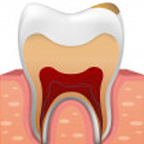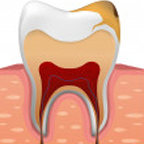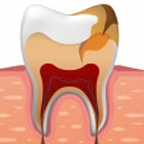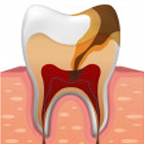Our smile is the most valuable asset on our face and clean white teeth the most desirable sight. Adults have 32 teeth – 8 incisors, 4 canines, 8 molars, 8 pre-molars, 4 wisdom, and children have 24 teeth by the age of eight. The wisdom teeth are the last to grow, completing the set of 32.
Our teeth do not reveal much about their health till there is a tinge of pain or discomfort. Tooth decay affects all ages, more so with older people as their gums tend to recede and enamel wears away. Younger people also suffer tooth decay due to food habits and poor oral hygiene.
More often than not, the starting phase of tooth decay attracts no attention. We tend to think that it will just go away or subside on its own. Since it happens in an area that we don’t look out for, the mind chooses not to dwell on it. The reality is that the condition gradually and steadily grows and festers, till there is pain enough to visit the dentist.
These are the different stages of tooth decay.
Stage 1 – The pin-hole sized white spot (PIT)
Our teeth are made of strong material called enamel. The acid and sugar content in the food we eat, when not rinsed off the teeth after each meal, are hard enough to penetrate the enamel. This causes a pin-hole sized white spot (PIT) to appear on the enamel surface. At this stage there is no pain or discomfort.

Stage 2 – The brown stain (FISSURE)
The pin-hole sized white spot that goes unnoticed keeps working on the tooth, eroding and damaging the enamel further, causing a brown stain on the surface. Even at this stage, there is little or no pain or discomfort, providing the perfect setting for a successful tooth-decay mission. The brown stain is visible and if noticed in time, can be cured.

Stage 3 – Dental caries or cavities
Bacteria that have been working hard on the enamel gain entry through a fissure into the dentin, which is the tissue just beneath the enamel. As dentin is not as hard as enamel, it makes it easier for the decay to progress rapidly. There is some amount of noticeable sensitivity at the fissure stage. The strength of the enamel being compromised gives way to small holes on the under-surface of the teeth. These are called dental caries or cavities.

Stage 4 – Deep Cavities
The pulp that houses the nerves and blood vessels is attacked at this stage and begins to swell up. The swelling pressurizes the nerves, causing pain, sensitivity and discomfort.

Stage 5 – Pus formation
The tooth is infected at this stage. Inflammation causes pus formation and a collection of this pus is a tooth abscess. It becomes unbearably painful, affecting the jaws, face and neck. Visiting the dentist is inevitable, and depending on the scale of damage, the tooth is retained or removed.

Treatment that follows a tooth decay can be any of these
- Fluoride treatment if the decay is in its early stage
- Tooth extraction and replacement with crown
- Removal of tissue and filling tooth with filling material
- Root canal treatment if the pulp is affected
The following points help prevent tooth decay and maintain good oral health.
- Brushing twice a day
- Flossing
- Using a fluoride toothpaste or mouth-rinse
- Reducing sweets, snacks, juices and aerated drinks
- Rinsing the mouth well after every meal or snack
- Visiting the dentist regularly to remove plaque build-up and to check for early signs of tooth decay
- Teaching children to brush, floss and rinse

